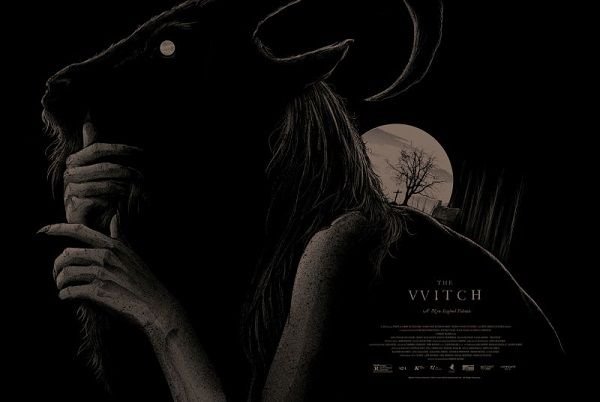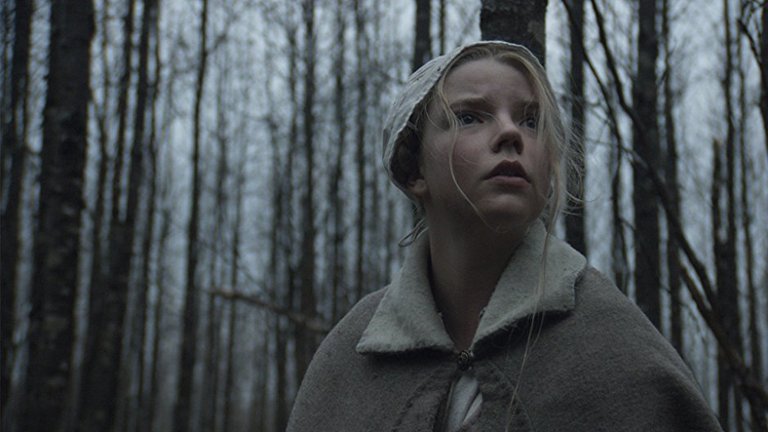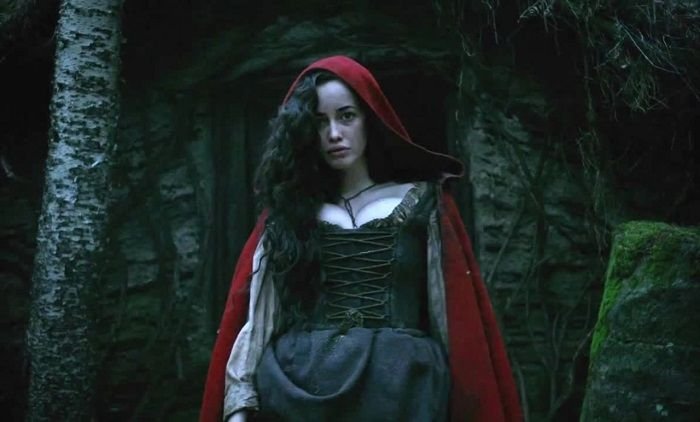Ineligible, but faithful to his Puritan fathers principle, is ousted from the colony in which he lives. He establishes himself with his wife and five children in the New World's wilderness. Selves, but united and independent, seeking constant support in the Supreme, they try to adapt to their isolated farm ... but soon their rest is disturbed by unexplained and sinister incidents caused by a mysterious and elusive presence.

In short, this is the story of the Witch's debut by Robert Eggers. But before we put the chilling horror on the court and we oversaw it in the sins of his fathers, as it would be right if we follow the biblical canons and especially the inquisitorial practice, let us first look at the sins in question, at least as regards the sins , sealed on a film strip - since the Swedish-Danish mute "Häxan" in 1922 has made one of the youngest cinematographic research on the subject. The truth is that, like many others under genres, the witch gennre is also sadistically squeezed, and the titles of the screen spells are bubbling and melting, and quite unpleasant to the taste. The latter include painful brain hemorrhages such as "Applied Magic" and "The Last Witch Hunter," while the first obedient are the lovely minimalist representatives of the underground - the Italian "La maschera del demonio" by Mario Bava , Mexico's "Veneno para las hadas" by Carlos Enrique Taboada and the "Curse Blair" by Daniel Mirik and Eduardo Sanchez are, for example, of great quality to excite your cinnamon neurons. The motif has a reflection of the symbiosis between cinema and literature, with inspirational curse of epochal and not so epochal screenings inspired by writers such as John Updike, Joanne Rowling, Neil Gaiman, Nikolay Gogol, A. Miller, William Shakespeare and others. (Not to mention that a single paragraph deserves the trio "The Three Mothers" by Dario Argentetto, but it will miraculously resist this tempting detour.) Abstracting from the art, we localize the witches' silhouettes, bent in the semantic, cultural and mythological nests from any geographic point of view for thousands of years, so you can not just root them out of the collective imagination of the audience and from the individual quests of the primary and constantly affectionate fetish in the consciousness of each and every one of us, yours from those extravagant waitresses who meditate at full moon with a black cat on their lap while they drink tea from a milled triton. "The Witch" verdict, especially in its purely conceptual, symbolic and artistic context, is more than justifiable. Egers has managed to strike a balance between what the previous supporters of the above-mentioned podium have achieved so far, and what is expressed by the essence of the folklore tradition, marked by the classic image of the pagan, mischievous and lustful witch. Most of the time evil is tangible but invisible - it serves as a fuel for paranoia, and the cruel and frightening moments in which you actually see a variety of anthropomorphic or animal aberrations are always in step with the mentally collapsing and unfortunate main characters whose torments are like crawling from the very abyss of madness. The most powerful is the sense of realism - it all reminds of a long-lost and cursed archive for which the perfect cast plays an important role: the actors look, speak and act infinitely convincingly (moderately excepted is the presence of the adults Ralph Inson, Julian Richards and Kate Dickie, they get out of the film, because they are relatively recognizable faces, but they too, what's left for the kids, as if they were teleported on the set of 1630 - the year the action unfolds). The fact that Egers has bravely embarked on a difficult and exhausting process of filming - in the midst of the wilderness, mostly natural light, in a battle with the unfavorable climate, speaks enough about his dedication as an author with a specific vision of the harsh conditions in which he wants to put the characters , and viewers. On top of that, he is also striving to optimally harvest the annoying and banal tricks of such productions, replacing them with almost exhausted patience to the details and overlapping tensions.

"The Witch" is a budgetly modest and independent project realized so well (pun intended) that an obscene amount of fancy words goes to him. Elegantly sticking to colossi like Karl Theodor Dreyer, Ingmar Bergman and Stanley Kubrick, but obediently consulting consultants to squeeze the colonial environment from-to, Egors approached with a focus on the alternation of static, nerve-keeping suspense, predatory voyeurism and stunning sound and musical incarnations (with an obsessively drenched female choir). An invaluable bonus is the bustling atmosphere, the melancholic but intense tone, the authentic atmosphere and language, the grim picture, verbally depicting the superstition and the discomfort of the then-North Americans, the dying men who use their religious crutch as an emotional-psychological placebo; their belief is consolation and explanation as it has been to millions of others facing extreme and unpredictable trials, but as fear grows in frank despair and tightening depression, it escalates to hysterical doubt, psychosis, and ultimately to staggering into direct pagan Occultism, as is the case with the sexually maturing Tomasin, played magnificently by Anja Taylor-Joe, emitting both virgin innocence and latent depravity.
"The Witch" is open for interpretation - it does not give definite answers, and it leaves you to build up what you see in your mind long after the end, letting you ask yourself insidious questions. Does Tomasin decide to make a pact with Lucifer and join the wardroom to protect her life? Or the temptation and the resulting decision are natural, voluntary and purposeful? Is it possible that all the ominous overture, passed through fierce, demonic and accusative suggestions and led to the bloody bath to the final, is actually a staging by the supernatural forces who have set out to recruit and join a consecutive servant in their commune? Are her younger brother and sister evil? Apparently they were under the control of Black Philip, but how real villains are they, not helpless pawns in the manipulative magic of the devilish figures in the woods - or the Devil himself?

At first, you adjust to the Witch, expecting a story without literally depicted monsters, a story that will turn out to be a fragment of someone who is sick, bullied by medieval beliefs and channeled them into personal, deadly madness. But the case is another - there is something terrible in the trees, and the aggressive goat is still a projection of the wicked, and their influence is detrimental to the naked children of God who have fallen into his dead and fair areas. In the picture, a subtle moral contour, through the cluttered and moral profile of the disintegrating family, devoted to its irrational understanding, was sacrificed to its unhealthy austerity, overpowered mercilessly by nature, defenseless in the absence of an adequately functioning society, but the search for a calf under the oxen would pollute the impressions of the true aims and qualities of the film: to convey a chilling mitopoetic tale, broken through the ancient folk art of the early settlers. The Witch is just that. Even the frame in which it is stated unequivocally that it is not about a terrible local plot, but about an entire chronicle from the epoch that uses direct quotations of people who lived in New England then helps us to look into this highly suppressed and saturated with a worry legend. That is why we should not complain that the allegorical potential is hindered at the expense of our merciless collision with the paranormal. (Eugers, a native of New Hampshire, says that the conception of the Witch is deeply rooted in the cultural and historical heritage of the region he grew up to, and he has tried to show brightly and sharply the nightmarish images and traditions have inhabited his childhood.)
In "The Witch", we can also look for another message - a critical illustration of the ideological stagnation of the XXVI century when a group of Europeans, victims of religious persecutions, fleeing their homeland to another continent to start anew and pure , but she herself excommunicates herself for her own absurd doctrinal considerations. The offspring in turn find themselves (voluntarily in the particular case with "The Witch") in the wild, where they are also so violently torn by verbal collisions and contradictions, until finally all this does not bring about the complete regression of the human, ending with throwing clothes and dancing a trance near the fire, with a leviency that could be a symbol of death, of the complete intellectual, emotional and physical corruption of a man who, however fled from his own, can not escape himself. (CxDean as the problem was "The Village" by M. Knight Shyamalan, although he refrained from the fantastic.) Although these reflections are probably not a direct reflection of the author's message, the good thing about "The Witch" is that it challenges you to think. First of all, this is absolute, electrifying horror, uncompromisingly acting according to the usual practices (more by spontaneity than by naturalism, although the latter is in decent quantities), but at the subconscious level is a purely human drama about our phobias of death and the unknown the battle with our dark half, and our helplessness, has collided with our primordial instinct for survival.
This was a truly disturbing movie. It was just so well done.
With a small budget, what miracles are being done :)
This was very interesting. I was never a huge fan of this film for some reason (I think it is a combination of the music and color that turns me off) but that is not to say that it wasn't well done.
I often, in half serious half trolling sort of way, argue that The Witch functions as a religious propaganda film. It would take more time than I am willing to spend right now to make that argument but I put a great deal of focus on the elder son's death scene and the "sinful" behavior that takes place after the family is separated from the religious authorities.
Anyway good post. Followed and Upvoted.
I know what you are talking about, but I think you are not right. The movie have the old spirit of the fairy tales like The Brothers Grimm, and the religious motif is always very strong there. And the dilemma is either you want to do something authentic or put it into the mold of modern, atheistic ideas in which the fairy tale can not exist.
True enough. When I make that argument it is a bit half hearted but I find that it is a fun one to make for some reason.
I don't actually think the religious aspect of the film is a bad thing, though. You don't have to think a thing is real to enjoy it as art.
Loved this film and its signalling of the rebirth of the folk horror genre.
Awesome movie ! I feel like this movie is so under appreciated ! Great post and great choice !
This makes it even more valuable :)
Very true lol glad I got a wicked steel book blu ray for this bad boy.
it same with me.....good horror movie...good post broo
Thanks :)
good post pana
thank you
Wow, what a fantastic and epic story. I had to just keep following, really captivating. Great message. Horror indeed
Cheers! :)
Dear friend, you do not appear to be following @artzone. Follow @artzone to get a valuable upvote on your quality post!
@artzone, I am following you :)
Great post!
Bot had a hard time following this post we are looking into the problem.
Gonna look for this movie so I can judge it by myself. Lol. Thank you for sharing, you really good explaining it.
If you have time, would you like to see my review on this movie:
https://steemit.com/movie-review/@noasalfha/watching-3-biri-gyaru-flying-colors-bilingual
I'll appreciate so much.
Have a good day :)
Sure. Have a good day too :)